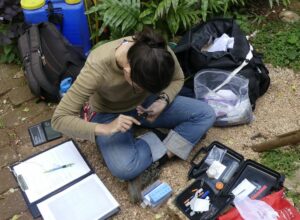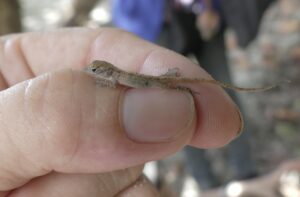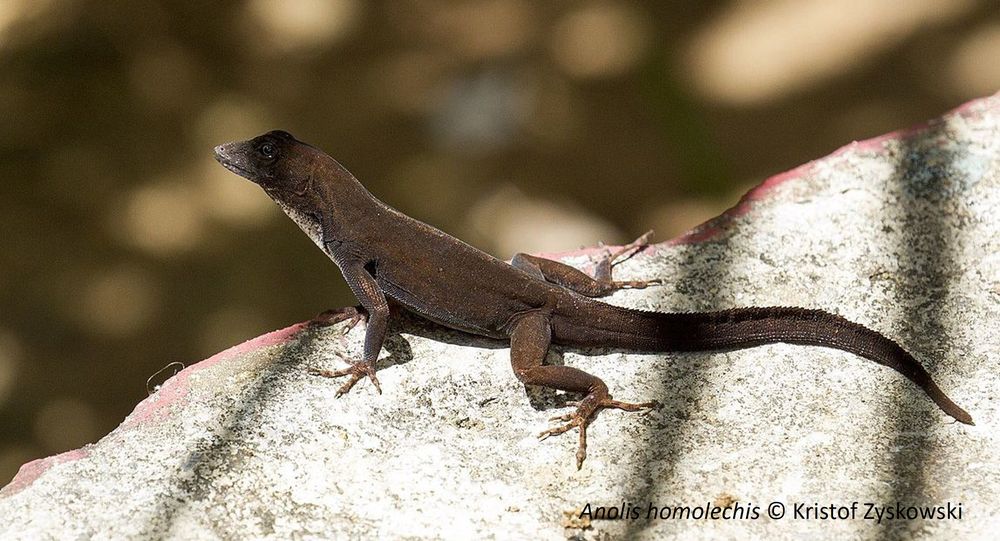In the ever-changing landscape of urbanization, the impact on local biodiversity is a growing concern. While many species face challenges in adapting to urban environments, some manage to thrive. A recent study has focused on the case of a lizard endemic to Cuba.
Rising urbanization is known to have direct negative consequences on biodiversity. Species that survive in urban environments are mostly generalists, and these environments also favor invasive exotic species. However, some native species manage to exist in these varied environments. In Cuba, the small lizard Anolis homolechis, endemic to the island, is found both in forest habitats and around urban areas.

Annabelle Vidal in the field
During her doctoral studies, Annabelle Vidal closely examined this species. By comparing adult lizards in suburban and forest areas, she highlighted behavioral differences (read the article), as well as morphological differences (read the article), which could be linked to various environmental constraints, including different predation pressure or resource availability, and variations in temperature.
In a newly published article, Annabelle Vidal explores the consequences of urbanization on the age-class structure of the species, focusing on both juveniles and adults. The aim is to better understanding the impact of urbanization on the demographic success and population dynamics of native species.
The methodology is similar to her previous studies. Over 20 months, more than a thousand individuals from two forest sites and two suburban sites were captured, measured, and marked with small colored tags to recognize them individually upon recapture. In addition, females were examined to determine if they were gravid (about to lay eggs) or not.
A major discovery, the study reveals that the proportion of juveniles in suburban habitats is four times lower than that measured in natural habitats. However, contrary to expectations, the study did not show differences in female fecundity based on the type of site. The lower proportion of juveniles near cities thus seems not be linked to lower reproductive capacity in females but could rather be explained by other factors.

Juvenile Anolis homolechis © Annabelle Vidal
A clue lies in the tail autotomy rate, an anti-predator behavior where lizards detach part of their tail when attacked by a predator to create enough diversion to escape. In the studied juveniles, this phenomenon was much more often observed in suburban environments than in forest environments, a result already highlighted in adults (read the article). Additionally, contrary to expectations, this autotomy rate was negatively correlated with the size of the juveniles: the larger they were, the less frequent autotomy occurred. According to the authors of the article, this result could be explained by increased predation in suburban environments by smaller predators. In particular, it could reflect a higher rate of cannibalism on juveniles in suburban areas, both by individuals of the same species and by individuals of other anole lizard species.
Beyond predation, the lower proportion of juveniles in urban environments could have other explanations detailed by the authors of the article. Higher temperatures in urban environments could lead to higher egg mortality. The transmission of pathogens between individuals could also be enhanced by urbanization.
This new study provides valuable information on how Anolis homolechis adapts to the challenges posed by urban environments. The observed age-class structure modification (proportion of juveniles) is likely to have many implications, especially in terms of population dynamics and stability. Studying these parameters in other species could contribute to a better understanding of the ability of native species to persist in urbanized areas.
About the Author
Annabelle Vidal completed her doctoral thesis in 2022 on the adaptation of Anolis lizards to the urban environment with the support of Caribaea Initiative. As a specialist in anole monitoring methods, she later participated in the MERCI project dedicated to invasive exotic reptiles, including initiating research programs on anoles in other territories. Still involved in the association’s activities, Annabelle currently lives in Cuba where she continues her research within the Institute of Ecology and Systematics.
Reference
Vidal, A. & Cézilly, F. (2024). What causes differences in the age-class structure between suburban and forest populations of Anolis homolechis? Diversity 16: 35. https://doi.org/10.3390/d16010035

